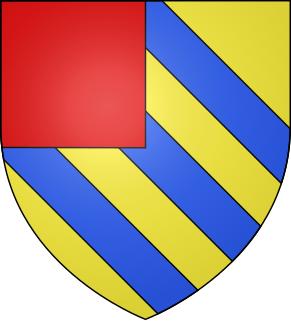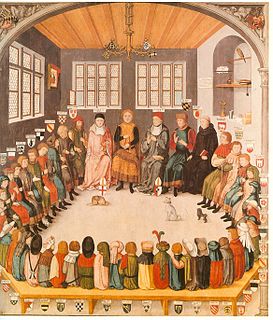Year 1387 (MCCCLXXXVII) was a common year starting on Tuesday of the Julian calendar.

Several counts and then royal dukes of Alençon have figured in French history. The title has been awarded to a younger brother of the French sovereign.

Albert III the Pious of Bavaria-Munich, since 1438 Duke of Bavaria-Munich. He was born in Wolfratshausen to Ernest, Duke of Bavaria and Elisabetta Visconti, daughter of Bernabò Visconti.

Frederick IV of Nuremberg (1287–1332) from the House of Hohenzollern was Burgrave of Nuremberg from 1300 to 1332. He was the younger son of Burgrave Frederick III from his second marriage with the Ascanian princess Helene, daughter of Duke Albert I of Saxony.

The Counts of Montfort were a German noble dynasty from Swabia. They belonged to high nobility of the Holy Roman Empire and enjoyed the privileged status of imperial immediacy.

Philipp Albrecht, Duke of Württemberg was the son of Albrecht, Duke of Württemberg, and Archduchess Margarete Sophie of Austria. He became head of the formerly reigning royal House of Württemberg on the death of his father in 1939.

Christoph of Württemberg, Duke of Württemberg ruled as Duke of Württemberg from 1550 until his death in 1568.
John of Foix was a younger son of Count Gaston IV of Foix and Queen Eleanor of Navarre. His elder brother was Gaston, Prince of Viana.

Sigmaringen Castle was the princely castle and seat of government for the Princes of Hohenzollern-Sigmaringen. Situated in the Swabian Alb region of Baden-Württemberg, Germany, this castle dominates the skyline of the town of Sigmaringen. The castle was rebuilt following a fire in 1893, and only the towers of the earlier medieval fortress remain. Schloss Sigmaringen was a family estate of the Swabian Hohenzollern family, a cadet branch of the Hohenzollern family, from which the German Emperors and kings of Prussia came. During the closing months of World War II, Schloss Sigmaringen was briefly the seat of the Vichy French Government after France was liberated by the Allies. The castle and museums may be visited throughout the year, but only on guided tours. It is still owned by the Hohenzollern-Sigmaringen family, although they no longer reside there.

The County of Sargans was a state of the Holy Roman Empire. From 1458 until the French Revolutionary War in 1798, Sargans became a condominium of the Old Swiss Confederacy, administered jointly by the cantons of Uri, Schwyz, Unterwalden, Lucerne, Zürich, Glarus and Zug.
Margaret of Bohemia was the younger daughter of Holy Roman Emperor Charles IV and his fourth wife Elizabeth of Pomerania. Her siblings included Anne of Bohemia and Holy Roman Emperor Sigismund.
Isabella of Navarre was the younger surviving daughter of Charles III of Navarre and his wife Eleanor of Castile. She was a member of the House of Évreux.

Eberhard I was Count of Württemberg from 1279 until his death. He was nicknamed 'der Erlauchte' or the Illustrious Highness.
The County Palatine of Tübingen was a state of the Holy Roman Empire in the medieval period. The dynasty, originally based in Nagold, managed to acquire extensive holdings over the course of their time in power, distinguishing themselves by founding a large number monasteries in their territories. By the time of the High Middle Ages, several factors contributed to their economic decline, including the expenses of keeping court and extravagant donations to the monasteries they founded. The line itself experienced fragmentation into numerous cadet branches, the longest-lasting of which were the Counts of Tübingen-Lichteck and the Counts of Montfort (1779).
The Bohemian Poděbrady family was a noble family in Bohemia, arising from the Lords of Kunštát. After Boček of Kunštát had acquired the Lordship of Poděbrady by marriage, he called himself "Boček of Kunštát and Poděbrady". The most prominent member of the family was George of Poděbrady, who was king of Bohemia. His sons were raised to imperial counts and Counts of Glatz. They founded the Silesian branch of the family, the Dukes of Dukes of Münsterberg.

Sabine of Württemberg was a princess of Württemberg by birth and by marriage, the first Landgravine of Hesse-Kassel.











